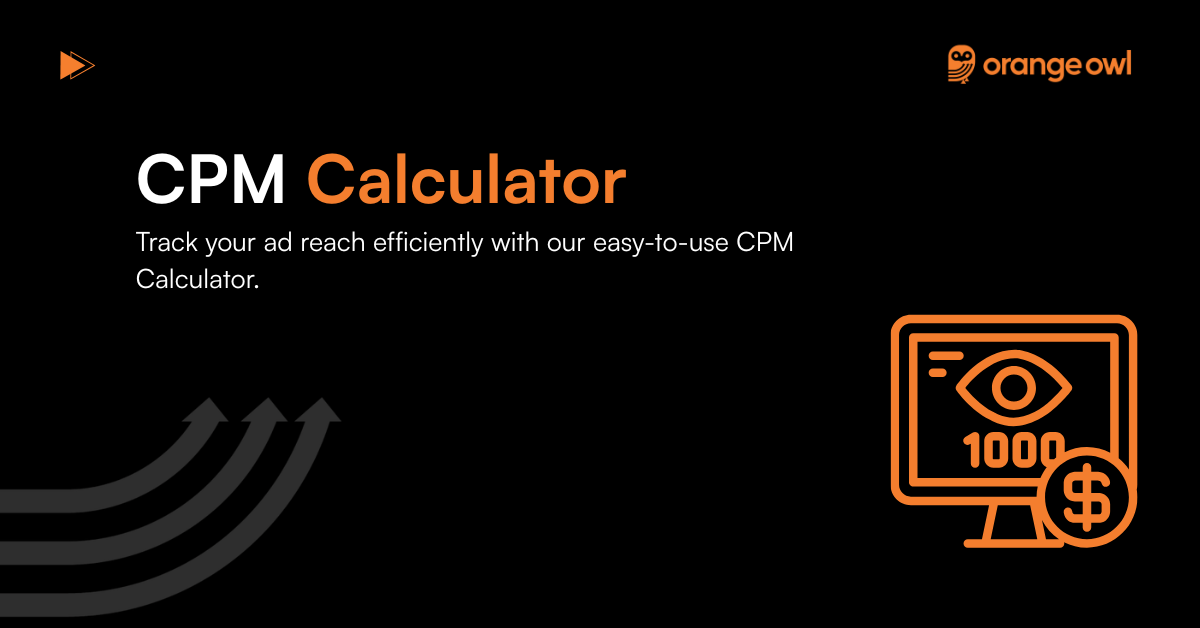CPM Calculator

Table of Contents
What is CPM (Cost Per Mille)?
CPM stands for Cost Per Thousand Impressions, where “mille” means 1,000. It’s a key metric in advertising that tells you how much you’re paying for every 1,000 views or impressions your ad receives.
Unlike CPA (Cost Per Acquisition) or CPC (Cost Per Click), CPM focuses on visibility over action. It’s widely used in brand awareness campaigns, where the goal is to get your message in front of as many people as possible, even if they don’t click or convert right away.
Example:
If you spend ₹10,000 and your ad is shown 200,000 times, your CPM is ₹50.
The lower your CPM, the more efficiently you’re buying visibility.
How to Calculate CPM
The formula for CPM is straightforward:

CPM Formula:
CPM = (Total Ad Spend ÷ Total Impressions) × 1,000
Example:
- Total Ad Spend: ₹5,000
- Total Impressions: 100,000
CPM = (5,000 ÷ 100,000) × 1,000 = ₹50
That means you’re paying ₹50 for every 1,000 people who see your ad.
What’s a Good CPM?
A “good” CPM depends on the platform, industry, and your campaign objective. But here are some typical benchmarks:
- ₹30–₹70 is common for platforms like Facebook or Instagram
- Programmatic or premium networks may charge ₹100+
- Niche B2B audiences usually have a higher CPM
- Retargeting CPMs are often lower due to audience familiarity
What matters most is whether you’re reaching the right audience, not just a large one.
Why CPM Matters
Even if you’re not measuring conversions directly, CPM helps you understand cost efficiency at the top of the funnel. It’s especially helpful when:
✅ Running brand awareness or product launch campaigns
✅ Comparing media buying options across platforms
✅ Evaluating reach vs. spend
✅ Planning ad budgets based on exposure goals
If you want to build visibility without relying solely on click-throughs, CPM is your go-to metric.
Metrics That Affect CPM
Just like other ad metrics, your CPM is influenced by multiple factors:
- Ad Quality: Better visuals and copy can lower costs
- Audience Targeting: Broader audiences often have cheaper CPMs
- Platform Competition: High-demand periods (like festivals or sales) increase CPM
- Ad Placement: Prime placements typically cost more
- Frequency Capping: Avoids overspending on the same audience
Improving these variables can help you stretch your budget further.
What Can Increase Your CPM?
If your CPM seems unusually high, here are a few reasons why:
- Highly competitive keywords or targeting
- Low-performing creatives or irrelevant messaging
- Narrow audience size, especially in niche markets
- Poor ad account history or low quality scores
- Running ads during peak bidding hours
Always audit your setup when CPM spikes unexpectedly.
How Marketers Use CPM
CPM is most effective when your goal is maximum exposure rather than direct conversion. Here’s how marketers typically use it:
- Brand awareness or top-of-funnel campaigns
- Measuring cost efficiency across ad platforms
- Planning reach-based campaign goals
- Supporting product launches, PR, or seasonal promotions
It gives a quick snapshot of how much reach you’re buying—and whether it’s worth the cost.
Using a CPM Calculator
A CPM calculator makes planning easy. Just enter:
- Total Spend
- Total Impressions
And it instantly tells you how much you’re paying per 1,000 views. Use it to compare campaigns, forecast budgets, or assess performance at a glance.
How to Lower Your CPM
You don’t always need a bigger ad budget—sometimes, you just need a better strategy. Here’s how to reduce your CPM:
- Target broader audiences where possible
- Use engaging, high-quality creatives
- A/B test different ad formats (carousel, video, static)
- Refine your timing and bidding strategy
- Improve your relevance score (on platforms like Meta or Google)
- Adjust frequency to avoid fatigue
Even small tweaks can help you reach more people for less.
When Should You Use CPM?
CPM is ideal when your marketing goal is awareness, visibility, or reach rather than immediate conversions. It’s beneficial for:
📣 Product or feature launches
🧠 Brand recall campaigns
📍 Geo-targeted visibility (e.g., events or local promotions)
🎥 Video views or media distribution
If your business needs maximum eyeballs, CPM is the metric to track.
How Orange Owl Helps You Lower CPM
At Orange Owl, we work with high-growth brands to drive more visibility at a lower cost. From creative testing and media planning to audience strategy and ad placement, we help you maximise reach without overpaying.
We don’t just help you track your CPM—we help you improve it. Because in today’s ad landscape, visibility isn’t enough—it needs to be efficient and impactful.
Frequently Asked Questions (FAQs) on CPM
CPM can differ greatly across platforms due to audience targeting, competition, and content type. LinkedIn typically has higher CPMs due to its professional audience, while Facebook and Google may offer lower CPMs but broader reach.
Not necessarily. A high CPM may indicate a competitive audience or premium placement, but it doesn’t always translate to better engagement or results. It’s important to track reach, impressions, and quality score alongside CPM.
Yes. CPM can be used in retargeting to maintain visibility among users who have already engaged with your brand. However, ensure frequency caps to avoid ad fatigue.
CPM rates usually rise during high-competition seasons like festivals, holidays, or year-end sales, as more advertisers bid for attention during these periods.
It depends. If your goal is brand visibility and reach, CPM works well. For direct sales, CPC or CPA might be more efficient.
CPM is best for visibility and reach. For performance-driven goals like conversions or app installs, CPA (Cost Per Acquisition) or CPC (Cost Per Click) models may be more effective.
